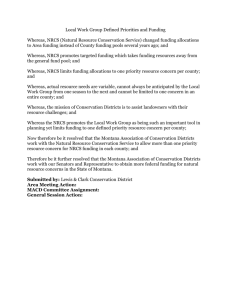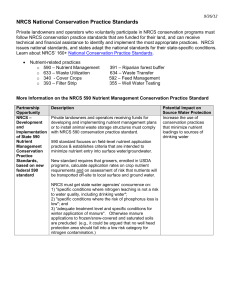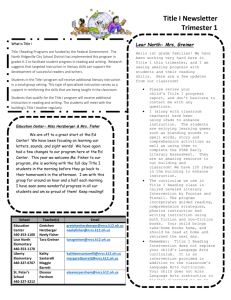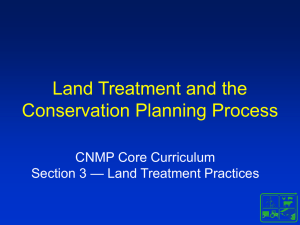319 Program Agricultural Best Management Practices
advertisement
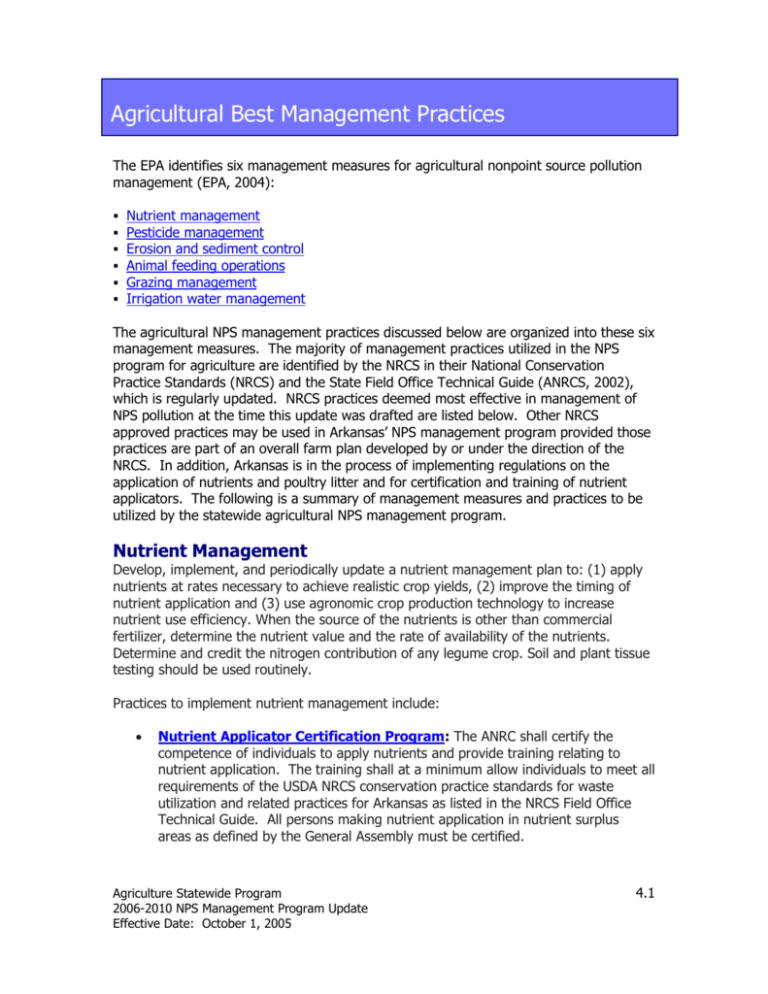
Agricultural Best Management Practices The EPA identifies six management measures for agricultural nonpoint source pollution management (EPA, 2004): Nutrient management Pesticide management Erosion and sediment control Animal feeding operations Grazing management Irrigation water management The agricultural NPS management practices discussed below are organized into these six management measures. The majority of management practices utilized in the NPS program for agriculture are identified by the NRCS in their National Conservation Practice Standards (NRCS) and the State Field Office Technical Guide (ANRCS, 2002), which is regularly updated. NRCS practices deemed most effective in management of NPS pollution at the time this update was drafted are listed below. Other NRCS approved practices may be used in Arkansas’ NPS management program provided those practices are part of an overall farm plan developed by or under the direction of the NRCS. In addition, Arkansas is in the process of implementing regulations on the application of nutrients and poultry litter and for certification and training of nutrient applicators. The following is a summary of management measures and practices to be utilized by the statewide agricultural NPS management program. Nutrient Management Develop, implement, and periodically update a nutrient management plan to: (1) apply nutrients at rates necessary to achieve realistic crop yields, (2) improve the timing of nutrient application and (3) use agronomic crop production technology to increase nutrient use efficiency. When the source of the nutrients is other than commercial fertilizer, determine the nutrient value and the rate of availability of the nutrients. Determine and credit the nitrogen contribution of any legume crop. Soil and plant tissue testing should be used routinely. Practices to implement nutrient management include: Nutrient Applicator Certification Program: The ANRC shall certify the competence of individuals to apply nutrients and provide training relating to nutrient application. The training shall at a minimum allow individuals to meet all requirements of the USDA NRCS conservation practice standards for waste utilization and related practices for Arkansas as listed in the NRCS Field Office Technical Guide. All persons making nutrient application in nutrient surplus areas as defined by the General Assembly must be certified. Agriculture Statewide Program 2006-2010 NPS Management Program Update Effective Date: October 1, 2005 4.1 Nutrient Management Planner Certification Program: The ANRC will implement a program to train and certify persons who prepare nutrient management plans. Nutrient management plans will indicate how nutrients should be applied to fields and other land for crop production while protecting ground and surface water from excessive nutrient enrichment. Nutrient and Poultry Litter Application and Management Program: ANRC will encourage prudent practices regarding the application and management of soil nutrients and poultry litter to protect and enhance the state’s surface water quality while allowing for optimum soil fertility and proper plant growth. The primary goal is to maintain the benefits derived from the wise use of poultry litter, commercial fertilizers and other soil nutrients while avoiding unwanted effects from excess nutrient applications on the waters of the state. In furtherance of this goal, these rules provide requirements applicable to nutrient surplus areas. These rules are designed to protect the waters within the state from adverse effects of excess nutrients while allowing for maximum soil fertility and proper plant growth. Nutrient Management: NRCS code 590 Pasture and hayland planting: NRCS code 512 Fencing: NRCS code 382 Filter strip: NRCS code 393 Mulching: NRCS code 484 Pesticide Management To reduce contamination of ground and surface water from pesticides: (1) Inventory pest problems, previous pest control measures and cropping history; (2) Evaluate the soil and physical characteristics of the site including mixing, loading and storage areas for potential leaching or runoff of pesticides. If leaching or runoff is found, steps should be taken to prevent further contamination; (3) Use integrated pest management (IPM) strategies that: apply pesticides only when an economic benefit to the producer will be achieved (i.e., applications based on economic thresholds) and apply pesticides efficiently and at times when runoff losses are least likely; (4) When pesticide applications are necessary and a choice of registered materials exists, consider the persistence, toxicity, runoff potential and leaching potential of products in making a selection; (5) Periodically calibrate pesticide application equipment; and (6) Use antibackflow devices on the water supply hose in addition to other safe mixing and loading practices such as a solid pad for mixing and loading and various new technologies for reducing mixing and loading risks. Practices to be utilized in implementing pesticide management include: Agriculture Statewide Program 2006-2010 NPS Management Program Update Effective Date: October 1, 2005 4.2 Integrated pest management: Management strategies that allow for better control with minimum risk to the environment. Resistant plants, cultural controls, soil amendments, beneficial insects, natural enemies, barriers, physical treatments, behavioral disruptants and biological and conventional pesticides are some of these management strategies Pesticide applicator training and licensing Proper pesticide storage, handling, and mixing Proper disposal of pesticides Pesticide collection Pest Management: NRCS 595 Erosion and Sediment Control Apply the erosion component of a resource management system (RMS) as defined in the Field Office Technical Guide of the USDA NRCS to minimize the delivery of sediment from agricultural lands to surface waters, or design and install a combination of management and physical practices to settle the settleable solids and associated pollutants in runoff delivered from the contributing area for storms of up to and including a 10-year, 24-hour frequency. Practices to be utilized in erosion and sediment control include: Conservation cover: NRCS 327 Conservation cropping rotation: NRCS 328 Residue Management No-Till/Strip Till: NRCS 329 A Residue Management Ridge Till: NRCS 329 C Residue Management Mulch Till: NRCS 329 B Contour farming: NRCS code 330 Cover crop: NRCS code 340 Critical area planting: NRCS code 342 Residue management: NRCS code 344 Filter Strips: NRCS 393 Grade stabilization structure: NRCS code 410 Agriculture Statewide Program 2006-2010 NPS Management Program Update Effective Date: October 1, 2005 4.3 Grassed waterway or outlet: NRCS code 412 Heavy use area protection: NRCS code 561 Hedgerow planting: NRCS code 422 Land smoothing: NRCS code 466 Mulching: NRCS code 484 Pasture and hayland planting: NRCS code 512 Prescribed grazing: NRCS code 556 Streambank and shoreline protection: NRCS code 580 Stripcropping: NRCS code 586 Structure for water control: NRCS code 587 Terrace: NRCS code 600 Tree/shrub establishment: NRCS code 612 Riparian forest buffer: NRCS code 391 Wetland restoration: NRCS code 657 Animal Feeding Operations Management Animal feeding operations (AFOs) should be managed to minimize impacts on water quality and public health. To meet this goal, management of AFOs should address the following eight components: (1) Divert clean water. Siting or management practices should divert clean water (runon from uplands, water from roofs) from contact with feedlots and holding pens, animal manure, or manure storage systems. (2) Prevent seepage. Buildings, collection systems, conveyance systems, and storage facilities should be designed and maintained to prevent seepage to ground and surface water. (3) Provide adequate storage. Liquid manure storage systems should be: (a) designed to safely store the quantity and contents of animal manure and wastewater produced, contaminated runoff from the facility, and rainfall from the 25year, 24-hour storm. (b) consistent with planned utilization or utilization practices and schedule. Dry manure, such as that produced in certain poultry and beef operations, should be stored Agriculture Statewide Program 4.4 2006-2010 NPS Management Program Update Effective Date: October 1, 2005 in production buildings, storage facilities or otherwise covered to prevent precipitation from coming into direct contact with the manure. (4) Apply manure in accordance with a nutrient management plan that meets the performance expectations of the nutrient management measure. (5 )Address lands receiving wastes. Areas receiving manure should be managed in accordance with the erosion and sediment control, irrigation, and grazing management measures as applicable, including practices such as crop and grazing management practices to minimize movement of nutrient and organic materials applied and buffers or other practices to trap, store and process materials that might move during precipitation events. (6) Recordkeeping. AFO operators should keep records that indicate the quantity of manure produced and its utilization or disposal method, including land application. (7) Mortality management. Dead animals should be managed in a way that does not adversely affect ground or surface water. (8) Consider the full range of environmental constraints and requirements. When siting a new or expanding facility, consideration should be given to the proximity of the facility to: (a) surface waters (b) areas of high leaching potential (c) areas of shallow ground water (d) sink holes or other sensitive areas. Additional factors to consider include siting to minimize off-site odor drift and the land base available for utilization of animal manure in accordance with the nutrient management measure. Manure should be used or disposed of in ways that reduce the risk of environmental degradation, including air quality and wildlife impacts, and comply with federal, state and local law. Programs and practices to be utilized in implementation of animal feeding operations and animal feeding operations management include: Nutrient Applicator Certification Program: The ANRC shall certify the competence of individuals to apply nutrients and provide training relating to nutrient application. The training shall at a minimum meet the USDA NRCS conservation practice standards for Arkansas. All persons making nutrient application in nutrient surplus areas as defined by the General Assembly must be certified. Nutrient Management Planner Certification Program: The ANRC will implement a program to train and certify persons who prepare nutrient management plans. Agriculture Statewide Program 2006-2010 NPS Management Program Update Effective Date: October 1, 2005 4.5 Nutrient management plans will indicate how nutrients should be applied to fields and other land for crop production while protecting ground and surface water from excessive nutrient enrichment. Nutrient and Poultry Litter Application and Management Program: ANRC will encourage prudent practices regarding the application and management of soil nutrients and poultry litter to protect and enhance the state’s surface water quality while allowing for optimum soil fertility and proper plant growth. The primary goal is to maintain the benefits derived from the wise use of poultry litter, commercial fertilizers and other soil nutrients while avoiding unwanted effects from excess nutrient applications on the waters of the state. In furtherance of this goal, these rules provide requirements applicable to nutrient surplus areas. These rules are designed to protect the waters within the state from adverse effects of excess nutrients while allowing for maximum soil fertility and proper plant growth. Poultry Feeding Operations Registration Program: Persons in the state of Arkansas who own or operate poultry feeding operations where 2,500 or more poultry are housed or confined on any given day will be required to register annually with ANRC. Such registration will include: o The number and type of birds housed or maintained by the operation o The location of the operation by latitude and longitude and county, township, range and section o The business address of the owner of the facility o The address of the facility if different from the owner's business address o The type of waste handling system o The type of litter management system and the amount of litter stored o The method used for carcass disposal o The acreage owned, controlled or used by the poultry feeding operation and used for landlord application of litter; o Tons of litter produced, removed, transferred or otherwise used by the poultry feeding operation and the type of transfer or usage; o The poultry integrator or integrators with which the poultry feeding operation has contracted to provide poultry litter; and o Any other relevant information deemed necessary by the ANRC Approved disposal of poultry and large animal carcasses. Arkansas Livestock and Poultry Commission (ALPC) regulations specify the acceptable disposal methods that address disease control concerns as well as environmental concerns. In addition, other organizations such as NRCS and Cooperative Extension Service maintain current recommendations for proper mortality disposal. o Approved burial of large animal carcasses: Carcasses may be buried at a site at least 100 yards away from a well and in a place where a stream cannot be contaminated. Anthrax carcasses are to be covered with 1 inch of lime. Other carcasses may be covered with lime, particularly to control odors. All carcasses are to be covered with at least 2 feet of dirt. Agriculture Statewide Program 2006-2010 NPS Management Program Update Effective Date: October 1, 2005 4.6 Carcasses are not to be buried in a landfill without prior approval of the state veterinarian. o Commercial dead animal disposal services: Commercial services may collect, process and dispose of animal carcasses provided all applicable rules and regulations of the ALPC are followed. o Approved disposal of poultry carcasses: Disposal of on-farm die-off of poultry may be through any method approved by ALPC including: extrusion, composting, freezing, incineration, rendering or cooking for swine feed. All handling and movement of carcasses must be in conformance with the regulations of the ALPC. o Emergency disposal of poultry carcasses: In the event of a major die-off, rendering will be the method of choice for disposal, except when death is caused by a disease entity. Alternately, a ditch may be used when dug 2 to 4 feet deep and covered by at least 2 feet of dirt. Lime may be used to control odor if needed. Practices to be utilized in management of animal feeding operations include: Critical area planting: NRCS code 342 Diversion: NRCS code 362 Fencing: NRCS code 382 Filter strip: NRCS code 393 Heavy use area protection: NRCS code 561 Irrigation system, sprinkler: (for application of liquid animal waste) NRCS code 442 Irrigation system, surface and subsurface: (for application of liquid animal waste) NRCS code 443 Nutrient management: NRCS code 590 Roof runoff structure: NRCS code 558 Waste storage facility: NRCS code 313 Waste treatment lagoon: NRCS code 359 Waste utilization: NRCS code 633 Grazing Management Manage rangeland, pasture and other grazing lands to protect water quality and aquatic and riparian habitat by: 1. Improving or maintaining the health and vigor of selected plant(s) and maintaining a stable and desired plant community while, at the same time, maintaining or improving water quality and quantity, reducing accelerated soil erosion, and maintaining or improving soil condition for sustainability of the Agriculture Statewide Program 2006-2010 NPS Management Program Update Effective Date: October 1, 2005 4.7 resource. These objectives should be met through the use of one or more of the following practices: 2. Maintain enough vegetative cover to prevent accelerated soil erosion due to wind and water manipulate the intensity, frequency, duration and season of grazing in such a manner that the impacts to vegetative and water quality will be positive ensure optimum water infiltration by managing to minimize soil compaction or other detrimental effects maintain or improve riparian and upland area vegetation protect stream banks from erosion manage for deposition of fecal material away from water bodies and to enhance nutrient cycling by better manure distribution and increased rate of decomposition promote ecological and stable plant communities on both upland and bottom land sites. 3. Excluding livestock, where appropriate, and/or controlling livestock access to and use of sensitive areas, such as stream banks, wetlands, estuaries, ponds, lake shores, soils prone to erosion and riparian zones, through the use of one or more of the following practices: use of improved grazing management systems (e.g., herding) to reduce physical disturbance of soil and vegetation and minimize direct loading of animal waste and sediment to sensitive areas installation of alternative drinking water sources installation of hardened access points for drinking water consumption where alternatives are not feasible placement of salt and additional shade, including artificial shelters, at locations and distances adequate to protect sensitive areas where necessary, provide stream crossings in areas selected to minimize the impacts of the crossings on water quality and habitat use of exclusionary practices, such as fencing (conventional and electric), hedgerows, moats and other practices as appropriate 4. Achieving either of the following on all rangeland, pasture, and other grazing lands not addressed above: apply the planning approach to implement the grazing land components in accordance with one or more of the following from NRCS: a Grazing Land Resource Management System (RMS); National Range and Pasture Handbook (USDA-NRCS, 1997); and NRCS Field Office Technical Guide, including NRCS Prescribed Grazing 528 maintain or improve grazing lands in accordance with activity plans or grazing permit requirements established by the Bureau of Land Management, the Agriculture Statewide Program 2006-2010 NPS Management Program Update Effective Date: October 1, 2005 4.8 National Park Service, the Bureau of Indian Affairs of the U.S. Department of Interior, the USDA Forest Service or other federal land managers Practices to be utilized in implementation of grazing management include: Critical area planting: NRCS code 342 Fencing: NRCS code 382 Filter strip: NRCS code 393 Grade stabilization structure: NRCS code 410 Grassed waterways: NRCS code 412 Heavy use area protection: NRCS code 561 Livestock exclusion: NRCS code 472 Nutrient management: NRCS code 590 Pasture and hayland planting: NRCS code 512 Planned grazing system: NRCS code 556 Pond: NRCS code 378 Prescribed grazing: NRCS code 528 Stream bank & shoreline protection: NRCS code 580 Tree planting: NRCS code 612 Trough or tank: NRCS code 614 Wetland development and restoration: NRCS code 657 Riparian forest buffer: NRCS code 391 Irrigation Water Management To reduce NPS pollution of ground and surface waters caused by irrigation: 1. Operate the irrigation system so that the timing and amount of irrigation water applied match crop water needs. This will require as a minimum: (a) the accurate measurement of soil-water depletion volume and the volume of irrigation water applied, and (b) uniform application of water. 2. When chemigation is used, include backflow prevention device(s) for wells; minimize the harmful amounts of chemigated waters that discharge from the edge of the field and control deep percolation. In cases where chemigation is performed with furrow irrigation systems, a tail water management system may be needed. The following limitations and special conditions apply: 1. In some locations, irrigation return flows are subject to other water rights or are required to maintain stream flow. In these special cases, on-site reuse could be precluded and would not be considered part of the management measure for such Agriculture Statewide Program 4.9 2006-2010 NPS Management Program Update Effective Date: October 1, 2005 locations. In these locations, improvements to irrigation systems and their management should still occur. 2. By increasing the water use efficiency, the discharge volume from the system will usually be reduced. While the total pollutant load may be reduced somewhat, there is the potential for an increase in the concentration of pollutants in the discharge. In these special cases, where living resources or human health may be adversely affected and where other management measures (nutrients and pesticides) do not reduce concentrations in the discharge, increasing water use efficiency would not be considered part of the management measure. 3. In some irrigation districts, the time interval between the order for and the delivery of irrigation water to the farm may limit the irrigator’s ability to achieve the maximum on-farm application efficiencies that are otherwise possible. 4. In some locations, leaching is necessary to control salt in the soil profile. Leaching for salt control should be limited to the leaching requirement for the root zone. 5. Where leakage from delivery systems or return flows supports wetlands or wildlife refuges, it may be preferable to modify the system to achieve a high level of efficiency and then divert the saved water to the wetland or wildlife refuge. This will improve the quality of water delivered to wetlands or wildlife refuges by preventing the introduction of pollutants from irrigated lands to such diverted water. 6. In some locations, sprinkler irrigation is used for frost or freeze protection, or for crop cooling. In these special cases, applications should be limited to the amount necessary for crop protection and applied water should remain on-site. Practices to be utilized in the implementation of irrigation management include: Irrigation regulating reservoir: NRCS code 522 Irrigation storage reservoir: NRCS code 436 Irrigation system, tail water recovery: NRCS code 447 Irrigation water management: NRCS code 449 Nutrient management: NRCS code 590 Irrigation landleveling: NRCS code 464 Irrigation water conveyance: NRCS code 430 DD Pumping plant: NRCS code 533 Grade stabilization structure: NRCS code 410 Critical area planting: NRCS code 342 Agriculture Statewide Program 2006-2010 NPS Management Program Update Effective Date: October 1, 2005 4.10

